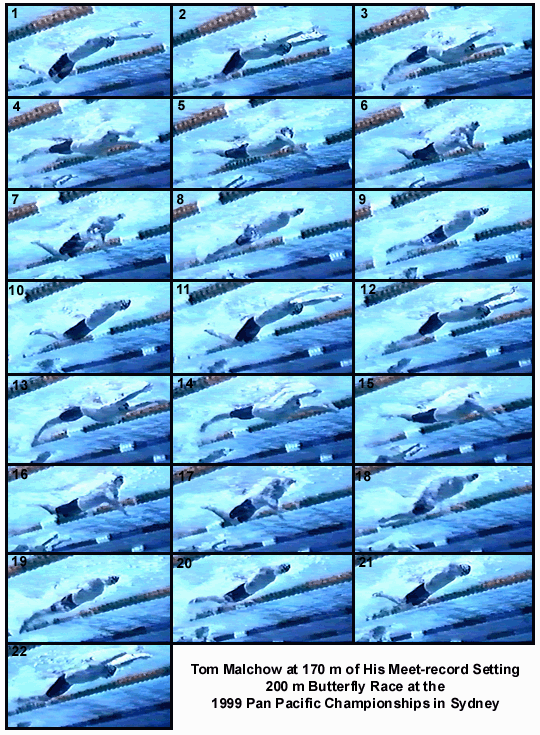HOW CHAMPIONS DO IT
Researched, produced, and prepared by Brent S. Rushall,
Ph.D., R.Psy.

TOM MALCHOW AT 170 m OF HIS MEET-RECORD SETTING 200 m BUTTERFLY RACE AT THE 1999 PAN PACIFIC CHAMPIONSHIPS IN SYDNEY
Each frame is .1 seconds apart. Tom Malchow's time for this race was 1:55.41, the #1 ranked swim in 1999 and the second fastest of all time.
Notable Features
Frame #1: The hands enter greater than shoulder width apart. The hands are turned outward losing an opportunity to immediately reposition the forearm/hand propelling surfaces to initiate a pull. The legs commence to kick. There is a certain attractiveness about the streamlining from the hips, through the head, and along the straight arms.
- Frame #2: The outward press of the hands does not create enough vertical force to keep the shoulders level. The shoulders continue to dive downward. The legs kick on an already flexed hip. The dropping shoulders and the kicking legs force the hips upward.
- Frame #3: By hyperextending the lower back, the upper torso remains relatively flat and the shoulder dive is halted. A head lift is initiated which also contributes to halting the shoulder dive. The back extension also supports a further rise of the hips as the leg kick is completed. The upper arms begin to medially rotate and the hands, particularly the left hand, begin to flatten at the same time as elbow flexion is initiated. The right hand faces outwards while the left hand is rotated towards the pool bottom.
- Frame #4: The hips flatten very quickly lifting the legs to be in alignment with the total body to produce a very improved degree of streamline. The very brief period of elevation of the hips, a period of less than .2 seconds, is a remarkable feature of this swimmer's stroke. The upper arms are adducted and the elbows flexed, but the right hand is still partly rotated outwards. Forward propulsion is increasing greatly at this stage while resistance from the body and legs is being reduced. The head rises to look forward.
- Frame #5: Both arms continue to propel as upper arm adduction occurs rapidly and powerfully. Drag force turbulence is coming off the right elbow. The feet rise to kick. The head continues to rise and look forward.
- Frame #6: Arm propulsion is near its maximum. Drag force turbulence follows the right arm. The legs prepare to kick. The head is reoriented to look to the bottom.
- Frame #7: Adduction of the upper arms is completed and both arms begin a partial extension while rising upward to exit. The arms are still propelling here because drag-force turbulence still follows the left arm. The legs kick. The face looks directly at the pool bottom.
- Frame #8: The elbows exit while propulsion continues off the hands. A very surprising feature of this frame is that the kick finishes at a position that would normally be halfway through. The total swimmer is very well streamlined although inclined marginally upward.
- Frame #9: A very quick recovery commences and the legs rise to position for a kick that needs to counter-balance the entry of the arms. The swimmer's streamlined position with the head down is maintained.
- Frame #10: The arms are well through the recovery, streamline is maintained, and the legs rise preparatory to kicking.
- Frame #11: The arms enter, the kick is initiated, and the swimmer's upper body streamline is retained. This position is similar to that displayed in frame #1.
- Frames #12 through #22. Another non-breathing stroke cycle is repeated.
Tom Malchow's stroke has three very distinguishing features.
- He performs one full and one half-kick. The most obvious reason for the half-kick is its relationship to a very quick recovery. For such a big man, the recovery (frames #8 through #11) is very fast (less than .3 seconds). This means that before recovering, the size of the kick has to be sufficient to counter-balance the exiting arms and to get back to the surface to kick again to counter-balance the entry of the arms. If the "exit-kick" had been larger, it would have taken more time and therefore, hindered or restricted what could be performed.
- Tom Malchow has excellent streamlining. For only a short time, probably less than .2 seconds, his hips rise way from streamline (frame #3). That length of time should be compared to that exhibited by other swimmers and in particular, female swimmers. A concentration on streamlining at all stages of the stroke and minimizing shoulder dive, much in the manner displayed by Mary T. Meagher, is worth emulating. One should also contemplate restricting kicking and hip and shoulder movements to preserve streamlining.
- Once the swimmer begins to propel, propulsive forces are maintained until the hands exit the water. Many butterflyers "attempt" to do this but often terminate propulsion before exiting. If a swimmer raises the exiting hands vertically while they are still underwater, then propulsion will cease. Tom Malchow continues to push backward while elevating his hands as part of the exit action. This continuation of effective propulsion to the very end of the stroke increases the length of the effective pull. Jenny Thompson and Michael Klim are other swimmers who exploit a full thrusting stroke whereas Denis Silantiev and Frank Esposito do not (the drag-force turbulence disappears off the hands before exiting).
Tom Malchow has the potential to rewrite the 200-m record as this stroke, and in particular, the set-up early in the arm pull, is developed further.

Return to Table of Contents for this section.




